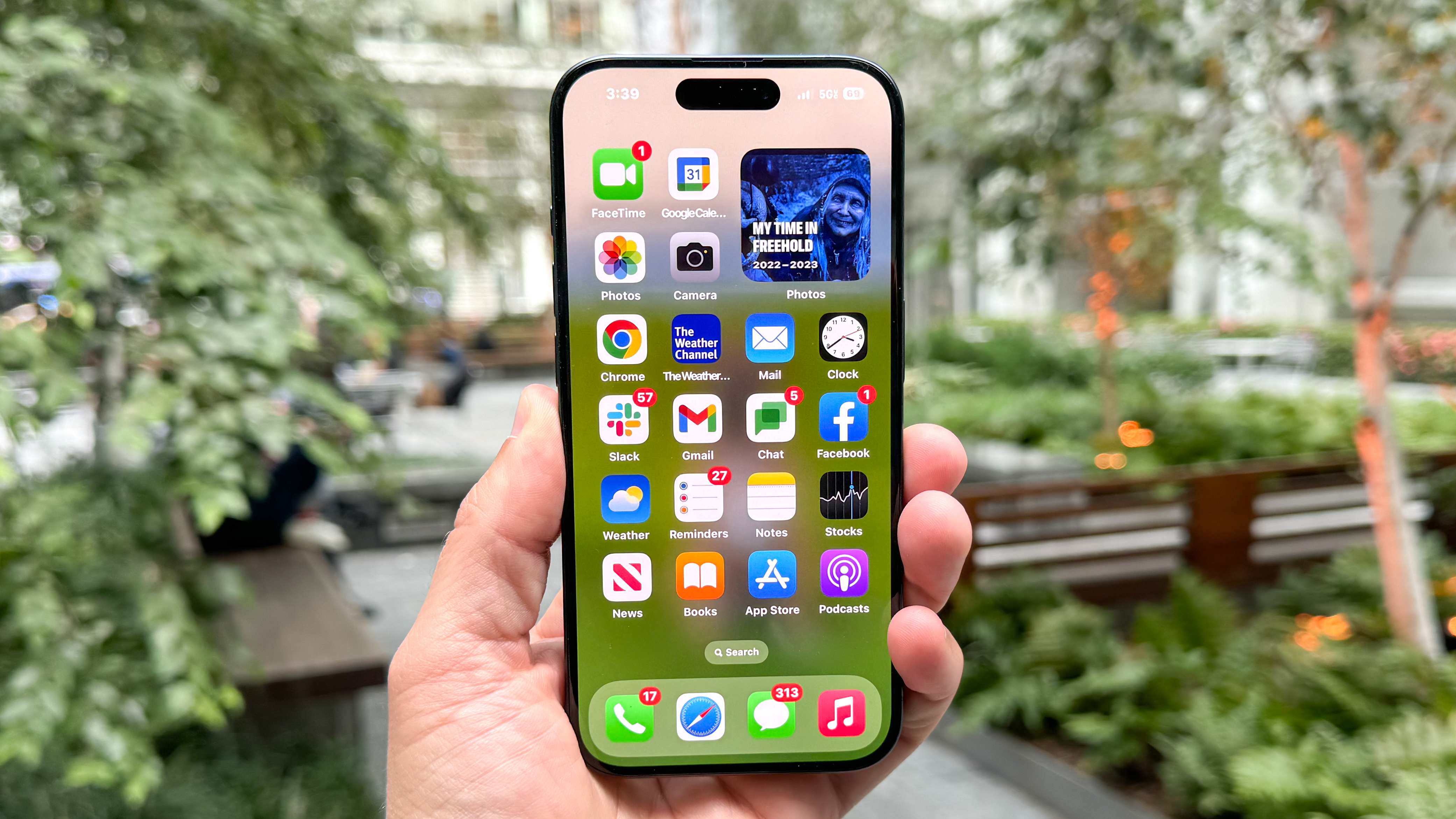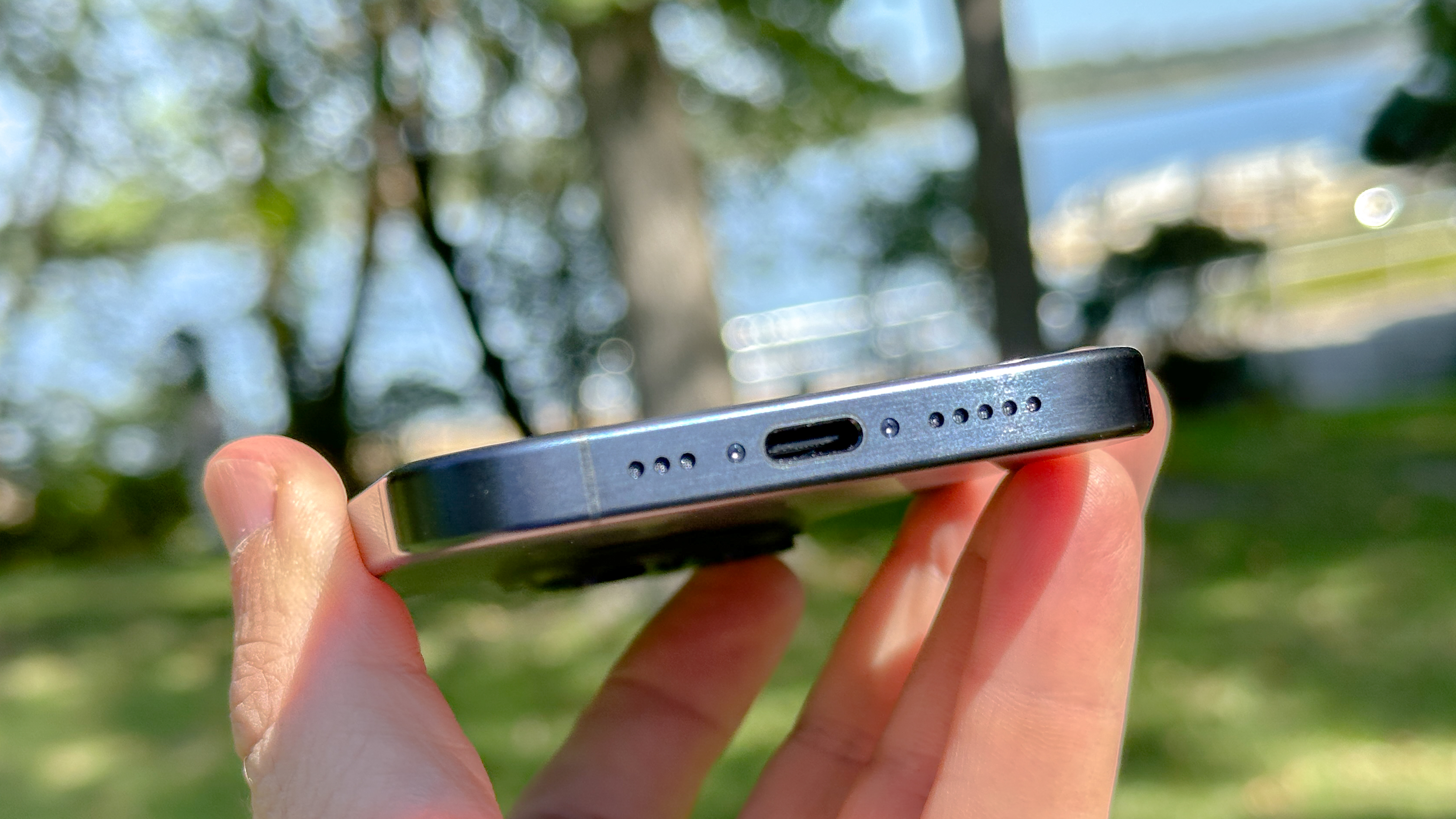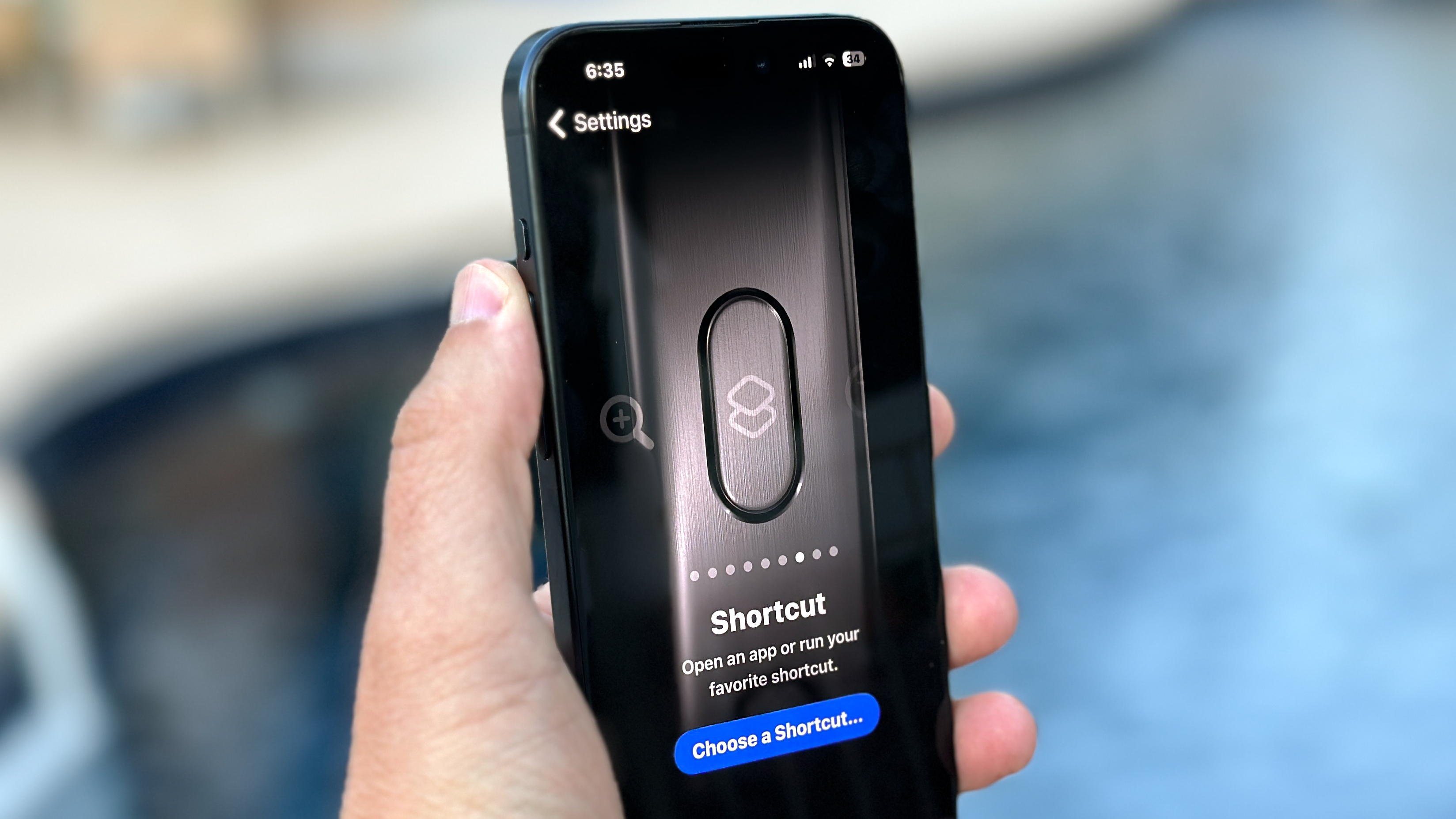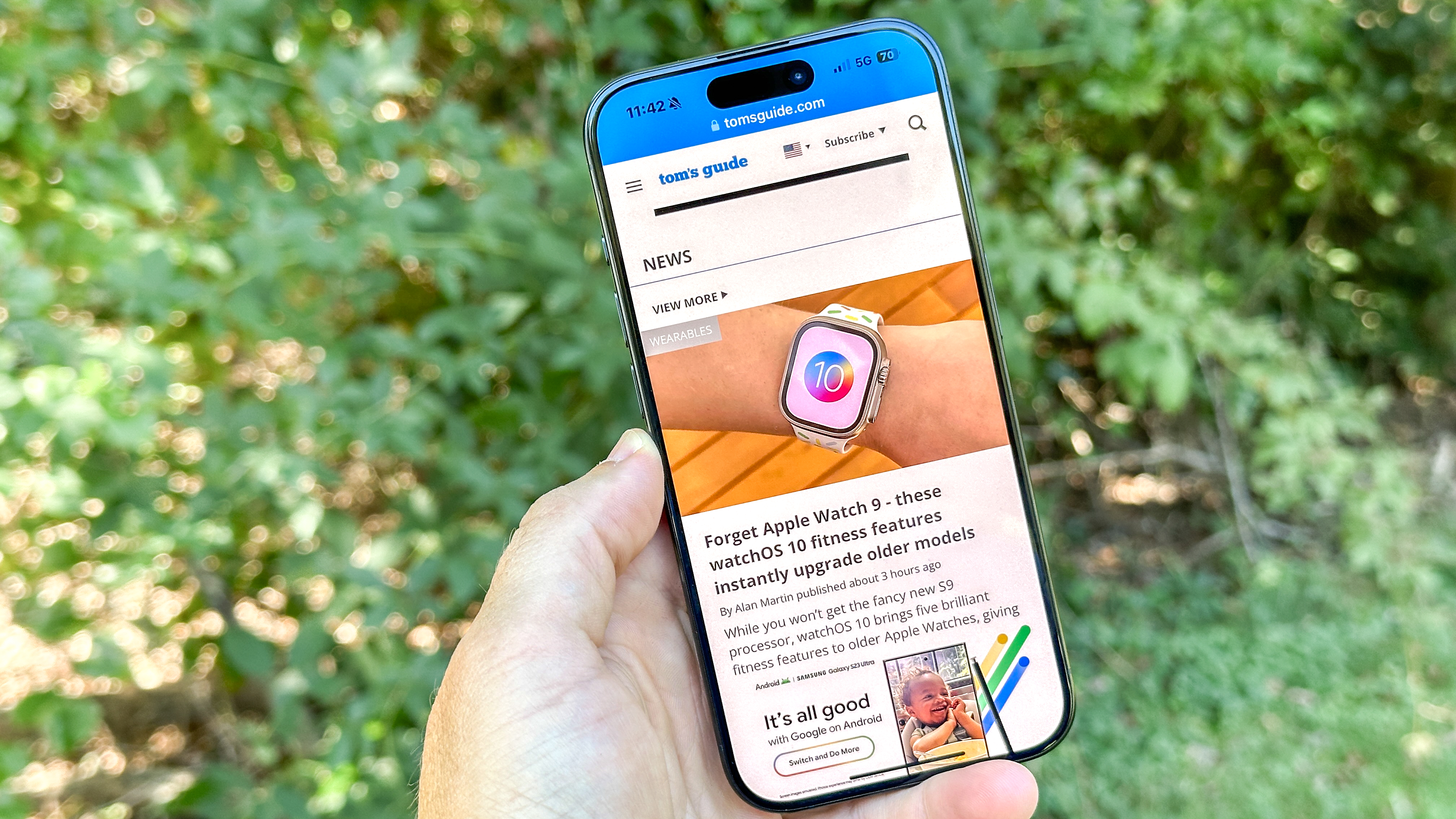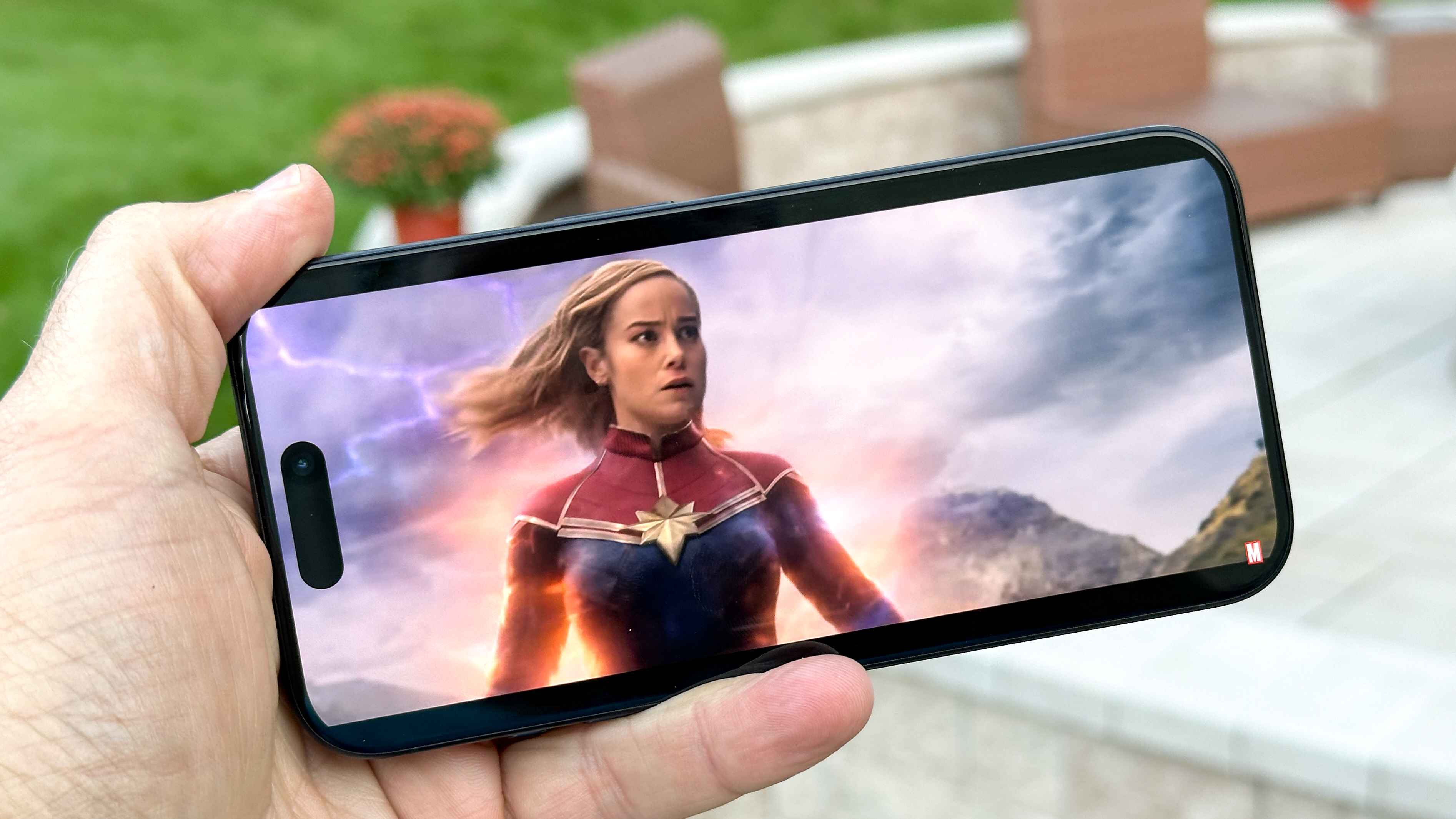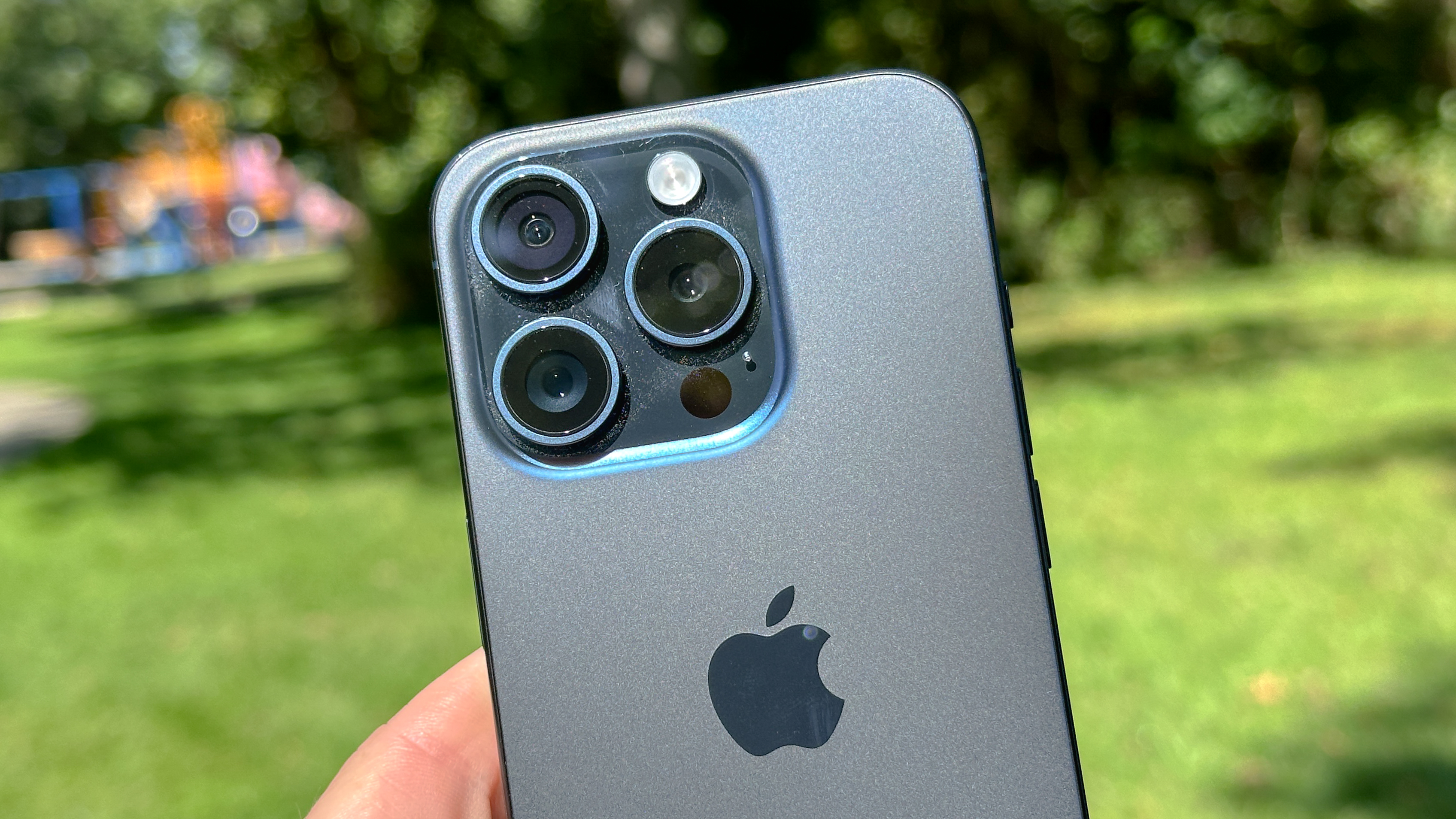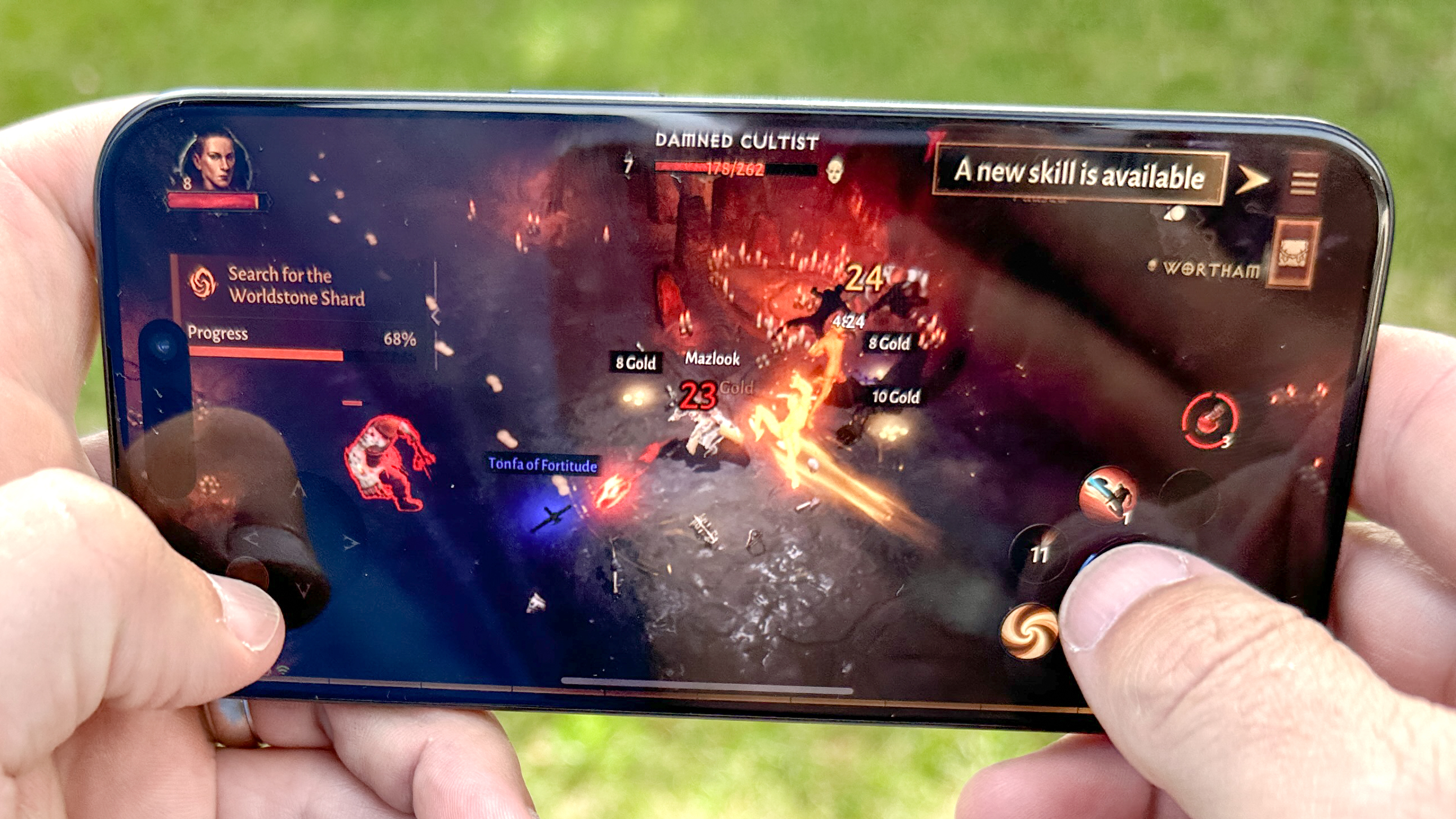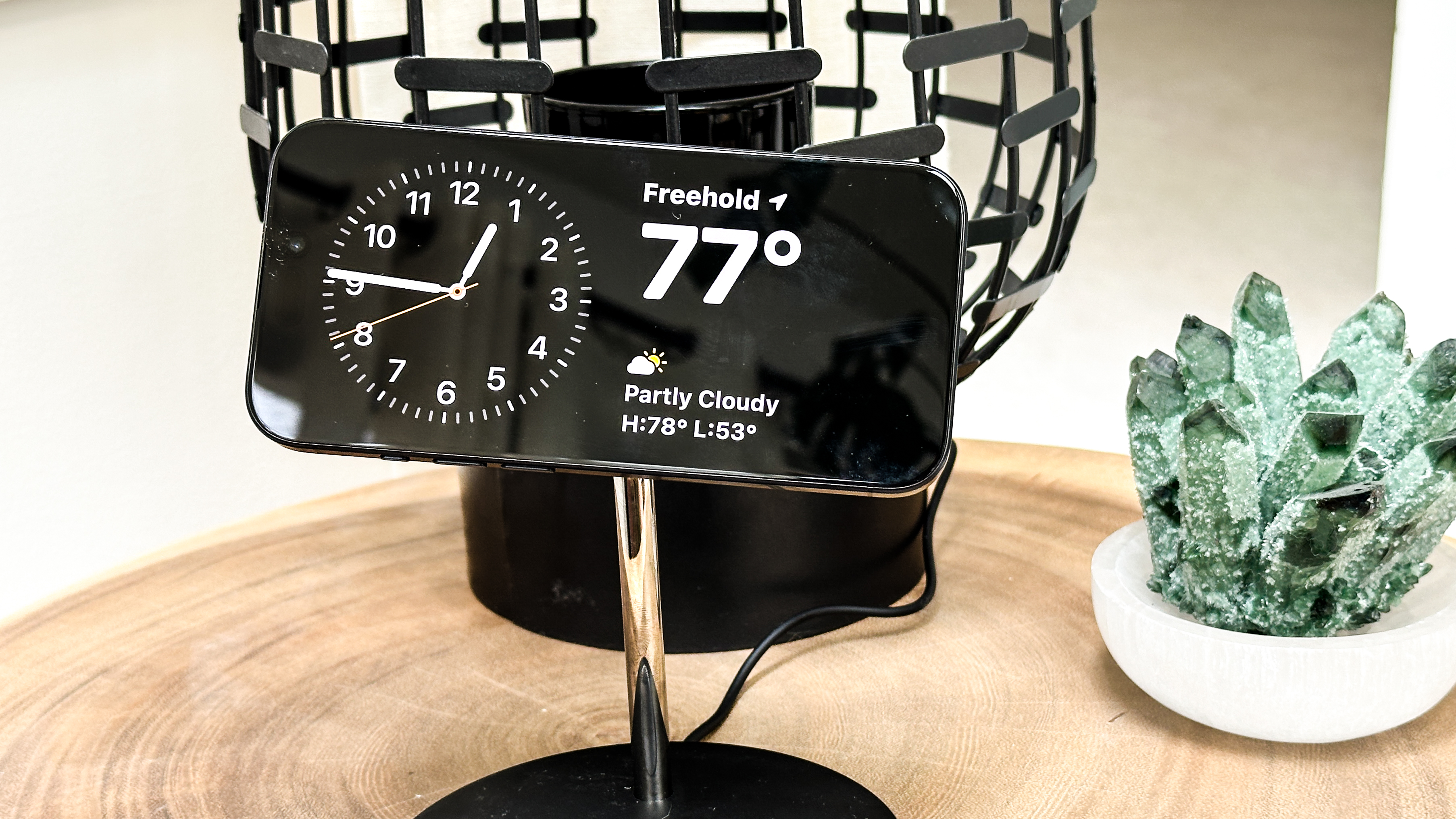Tom's Guide Verdict
The iPhone 15 Pro is the phone to get if you want a powerful flagship you can easily use it with one hand. Not only is the titanium design stronger and lighter, Apple made the design smaller with slimmer bezels. You also get very strong cameras with night mode and portrait improvements, blazing performance from the A17 Pro chip and a smart Action button. Too bad only the iPhone 15 Pro Max gets the longer 5x zoom.
Pros
- +
Stronger, lighter Titanium design
- +
Super fast A17 Pro chip
- +
Handy Action button
- +
Excellent cameras
Cons
- -
Only Pro Max gets longer optical zoom
- -
Same charging speeds as before
Why you can trust Tom's Guide
The iPhone 15 Pro is notable just as much for what Apple has taken away as what it has added. Hated the Lightning port? It’s gone, replaced with USB-C. Never use the ringer switch? It’s now an Action button that mutes calls and perform various shortcuts. Apple even took away some inches and ounces, thanks to a lighter and stronger titanium design and slimmer bezels all around.
What you’re left with is what I call the iPhone 15 Pro mini, as this flagship is very easy to use with one hand. You get a superfast A17 Pro chip and a camera system that produces even better portraits and low-light shots. However, the iPhone 15 Pro vs iPhone 15 Pro Max divide has grown, as only the Pro Max offers a longer 5x optical zoom. And the battery life difference is also significant based on our testing.
Yes, the iPhone 15 Pro is one of the best iPhones and belongs on our best phones list overall, but it’s not my top pick. Here’s the pros and cons in my in-depth iPhone 15 Pro review.
iPhone 15 Pro review: Release date and price
The iPhone 15 Pro came out last September with a starting price of $999 for 128GB of storage — exactly what Apple charged for the iPhone 14 Pro. I would have liked to see 256GB standard for a phone that offers 48MP ProRAW photos and ProRes video capture, but you can upgrade to 256GB for an extra $100.
If you want more storage, the 512GB option is $1,299 and 1TB costs $1,499. If you want the best discounts, check out our iPhone 15 deals page. And keep tabs on our iPhone 15 Pro delays guide for the latest shipping estimates.
Since our review was first published, Samsung released the annual update to its Galaxy S phones, which includes the Galaxy S24 Plus. While that phone has the same $999 price as the iPhone 15 Pro, it also features 256GB in its base model and comes with a larger screen. The 6.2-inch Galaxy S24 is closer in size to the iPhone 15 Pro but costs $200 less.
iPhone 15 Pro review: Design
The iPhone 15 Pro looks and feels like a shrunken flagship, and I mean that in a good way. Apple ditched the stainless steel band for a tougher and lighter aluminum, and I immediately felt the difference when I picked up this device. It weighs 6.6 ounces, compared to 7.27 ounces for the iPhone 14 Pro. Both older Samsung Galaxy S23 and Galaxy S24 are still lighter at 5.93 ounces each.
Get instant access to breaking news, the hottest reviews, great deals and helpful tips.
However, the iPhone 15 Pro is not as tall as the Galaxy S24, measuring 5.77 x 2.78 x 0.32 inches versus 5.79 x 2.78 x 0.3 inches for the latest Samsung flagship. This is thanks to Apple offering its smallest bezels ever on an iPhone.
| Row 0 - Cell 0 | Weight | Dimensions |
| iPhone 15 Pro (6.1 inches) | 6.6 ounces | 5.77 x 2.78 x 0.32 inches |
| iPhone 14 Pro (6.1 inches) | 7.27 ounces | 5.81 x 2.81 x 0.31 inches |
| Galaxy S23 (6.1 inches) | 5.93 ounces | 5.76 x 2.79 x 0.36 inches |
| Galaxy S24 (6.2 inches) | 5.93 ounces | 5.79 x 2.78 x 0.30 inches |
| Pixel 7 Pro (6.3 inches) | 6.9 ounces | 6.1 x 2.9 x 0.3 inches |
It gets better. The iPhone 15 Pro has a new contoured design, so the edges are rounded instead of sharp and squared off. I found that this makes the new iPhone more comfortable to hold, as it doesn’t dig into your hands.
The iPhone 15 Pro color options aren’t exactly thrilling. I tested Blue Titanium, which pops the most of the bunch. But I really like the Natural Titanium option for a more minimalist look. The Black Titanium and White Titanium models are kinda meh.
iPhone 15 Pro review: USB-C
Apple has (unwillingly) made the jump from the Lightning connector to USB-C, and there’s clear benefits for users. For one, you can charge your iPhone, MacBook and iPad all using the same cables. Yes, there’s a cable in the box but no charger as with other recent iPhones.
The iPhone 15 Pro supports USB 3 transfers to your MacBook or a storage device at up to 10Gbps speeds, which is better than the USB 2 speeds offered by the regular iPhone 15 series. Just keep in mind that you’ll need to buy a separate USB 3-rated cable ($159 through Apple).
Another plus is that you can charge other Apple devices from your iPhone via USB-C. This includes the Apple Watch and the AirPods Pro 2 with USB-C charging case. I tried this and the new AirPods started charging instantly.
iPhone 15 Pro review: Action button
It’s time to hang up on the mute switch. The iPhone 15 Pro replaces it with a new Action button, which by default toggles Silent mode on and off with a long press. So you don’t lose anything; you can even feel the vibration in your pocket so you know what mode your phone is in. A short press tells you the current ringer status.
Things get a lot more interesting when you dive into the Settings app, where you can assign various shortcuts to the Action button using an intuitive interface. You can choose to launch the camera, flashlight, voice recorder, magnifier and more. Some of the options let you customize actions within an app. For example, I tried launching straight into a selfie with the Action button.
If you want to get very creative, you can use the Shortcuts app on your iPhone to program very specific actions. You can launch any app you want (I tried Spotify), start a text with a specific contact or pick your robot vacuum out of the pool. The only bummer with the Action button is that you can assign it only a single action at once. I hope Apple opens things up over time.
iPhone 15 Pro review: Display
The iPhone 15 Pro’s 6.1-inch display doesn’t bring anything new to the table, but based on my testing it’s still one of the best OLED screens you’ll find on a phone. And because the bezels are smaller now, the experience is a bit more immersive.
Two other welcome features carry over from the iPhone 14 Pro. The Dynamic Island comes in handy for live alerts and activities at the top of the screen, whether you want to see the status of your Uber ride, switch Spotify tracks or check your United flight info on the fly.
The second feature is the always-on display, which lets you check the time, battery status and notifications without having to unlock your phone.
When watching the trailer for The Marvels, Brie Larson’s red, blue and gold outfit popped against an electrified sky. And because this is a 120Hz panel, you’ll enjoy smooth scrolling and gameplay in supported titles.
| Row 0 - Cell 0 | iPhone 15 Pro | Galaxy S23 | Galaxy S24 |
| Max brightness (HDR) | 1,550 nits | 1,340 nits | 1,416 nits |
| sRGB | 117.8% | 128.6% Natural / 212.1% | 120.8% Natural / 137.5% Vivid |
| DCI-P3 | 83.5% | 91.1% Natural / 150.2% Vivid | 85.5% Natural / 97.4% Vivid |
| Delta-E (lower is better) | 0.14 | 0.24 Natural / 0.34 Vivid | 0.24 Natural / 0.22 Vivid |
The iPhone 15 Pro’s display is rated for 1,600 nits of peak brightness and 2,000 nits in direct sunlight. In our testing, we saw 1,550 nits when showing HDR content, which is considerably brighter than the Galaxy S23’s 1,340 nits and still ahead of the Galaxy S24's 1,416-nit reading.
In terms of color reproduction, the new iPhone 15 Pro fell behind the Galaxy S23 on the sRGB and DCI-P3 tests — so Samsung offers more colors overall. But the iPhone delivered more accurate hues than either Galaxy S model with a Delta-E score of 0.14 (where 0 is best).
iPhone 15 Pro review: Cameras
The iPhone 15 Pro packs a number of great camera upgrades, including a physically bigger main 48MP sensor that shoots 24MP pics by default. You can always go higher with 48MP ProRAW photos or pick the HEIFF format to save space.
The iPhone 15 Pro also lets you take portrait shots without having to enter Portrait mode, as it can sense depth info in your photos. After you shoot, you can control not just the depth effect but also choose your focus point with a tap. And the Night mode also gets a Photonic Engine boost with even better low-light shots.
Based on my extensive camera testing versus the best camera phones, the iPhone 15 Pro delivers consistently great results with the most dynamic range. Just don’t expect the best zoom.
In this shot of a foot bridge at Little Island Park in New York City, the iPhone 15 Pro delivers more details in the stone especially towards the top, while the Galaxy S23 Ultra blows this out. But Samsung’s phone does a better job exposing the shadowy area underneath.
I give the nod to the iPhone 15 Pro in this pic of some produce. The red, green and orange peppers have a bit more texture to them in Apple’s photo. Even though the Galaxy S23 Ultra produces a brighter shot, the purple peppers look a bit blown out in the top part of the frame.
The iPhone 15 Pro sticks with the same 3x telephoto zoom as the iPhone 14 Pro, while only the iPhone 15 Pro Max makes the jump to 5x with its tetraprism lens. The new 15 Pro also has a shorter digital zoom range at 15x versus 25x for the Pro Max. By comparison, the Galaxy S23 has a 3x optical zoom but 30x digital zoom, and the Pixel 7 Pro has a 5x optical zoom and 30x digital.
In this 3x zoom shot of the Empire State Building, I give a slight edge to the iPhone 15 Pro because the trees look richer and brighter in the foreground and you can make out more detail in the brick building off to the left. But the Empire State Building itself is a tad sharper though the Pixel 7 Pro.
At 15x zoom, the iPhone 15 Pro’s photo of this eagle isn’t nearly as sharp as the Galaxy S23 Ultra (though it’s a pricier phone) and the Pixel 7 Pro’s attempt is crisper as well.
In low light the iPhone 15 Pro wins hands-down. Check out this photo of Halloween decorations. The iPhone delivers the best detail in the lady scarecrow and pumpkins. The Samsung shot has an orange cast to it and vibrates a bit, and the Pixel photo is too dim.
So what about portraits? The iPhone 15 Pro delivers more detail in my shirt, face and hair in this pic, although some will prefer the Galaxy S23 Ultra’s shot because it’s brighter while smoothing out my face.
The iPhone 15 Pro also wins this selfie portrait comparison. My eyes, skin and hair look a lot clearer through the iPhone, while there’s a bit of a haze over the Samsung shot.
I took these two macro shots of a white poppy flower with the iPhone 15 Pro and Pixel 7 Pro, and it’s not really close. The iPhone’s shot has a mesmerizing amount of detail with a warmer color tone, while the Pixel 7 Pro is very blurry on the right side.
The Pixel 7 Pro strikes back with this close-up of a fruit tart using the main camera. The blueberries in particular have more detail, as does the front edge of the pastry.
This last shot using the ultrawide camera is a bit of a toss-up as both the Galaxy S23 Ultra and iPhone 15 Pro capture a crisp and colorful photo of a river pier. The iPhone’s photo delivers a more realistic gradation of color in the blue sky, and there’s more contrast in the sand off to the left. But I could see more people sharing the eye-poppingly blue Samsung pic.
iPhone 15 Pro review: Video
The iPhone 15 Pro is a killer tool for videographers, and there’s some notable upgrades from Apple, including support for up to 3x zoom in Cinematic mode and the ability to record directly to an external SSD drive at up to 4K and 60 frames per second in ProRes mode.
Plus, creative pros will appreciate that the iPhone 15 Pro supports the Academy Color Encoding System (ACES) standard for color workflows.
In this first 4K clip of a fountain, the iPhone 15 Pro delivers stunningly smooth, colorful and detailed footage. You feel like you’re right in front of the fish as they swim about, and I appreciated how crisp the bubbles were as I zoomed in. The sunlight shimmering against the post caught my eye as well.
I also panned around the beach at Manasquan River state park at 4K 30fps using both the iPhone 15 Pro and Galaxy S23 Ultra. The iPhone blows away the S23 Ultra with brighter and more colorful footage, though it takes a back seat to Samsung on detail as we zoom in on a rower.
iPhone 15 Pro review: Performance
It probably won’t surprise you to hear that the iPhone 15 Pro is fast, thanks to its A17 Pro chip. But it’s more about what this processor enables than its benchmark scores.
As the world’s first 3nm chip, the A17 Pro promises 10% better CPU performance, up to 2x faster performance in machine learning tasks (think autocorrect, on-device Siri interactions, etc) and up to 20% faster graphics speed with its 6-core GPU.
This GPU also supports ray tracing, which delivers console-like lighting and reflections in games, something I tried in Diablo Immortal. I got completely sucked in by this title, as I followed enemy footsteps to battle over a dozen enemies on screen at once. The action never slowed down, and everything from the moonlight reflecting off puddles on the ground to the electric charges coming from my fist wowed.
Apple is also working with game developers to bring AAA titles to the iPhone, including Capcom’s Resident Evil Village. I was appropriately horrified as zombies kept trying to bite my arm and I tried to fend them off with a gun, knife and then just running. The touch controls were quite dizzying, so you might want to pick up a dedicated gaming controller that snaps onto your iPhone if you’re serious about gaming.
| Row 0 - Cell 0 | iPhone 15 Pro | Galaxy S23 Ultra | Galaxy S24 Plus |
| Geekbench | 2,890 / 7,194 | 1,396 / 4,882 | 2,272 / 7,083 |
| 3DMark Wild Life Unlimited | 94.3 fps / 15,747 | 87 fps / 14,611 | 121.3 / 20,253 |
| Adobe Premiere Rush (video editing) | 25.5 seconds | 40 seconds | 42 seconds |
On Geekbench, which measures overall performance, the iPhone 15 Pro hit 2,890 on single-core and 78,94 on multi-core, compared to just 1,396 / 4,882 from the Galaxy S23 Ultra’s Snapdragon 8 Gen 2 chip. The Snapdragon 8 Gen 3 powering the Galaxy S24 Plus still trails the A17 Pro's Geekbench numbers, but the gap has narrowed considerably.
Apple no longer offers the better graphics performance, as the Galaxy S24 Plus posts a 121.3 frames per second result on 3DMark's Wild Life Unlimited test. That's better than the iPhone 15 Pro's 94.3 fps result. If you're looking for the best gaming phone, you'd turn to the latest Samsung flagships ahead of the iPhone.
The iPhone also continues to lead in tasks like video editing, with the iPhone 15 Pro needing just 25.5 seconds to transcode a 4K video to 1080p. Last year's S23 Ultra needed 40 seconds, while the S24 Plus took a step backward.
iPhone 15 Pro review: Battery life and charging
The iPhone 15 Pro’s endurance is better than the iPhone 14 Pro, but it’s not enough to make our list of best phone battery life.
On our battery test, which involves continuous web surfing at 150 nits of screen brightness, the iPhone 15 Pro lasted 10 hours and 53 minutes. That’s 40 minutes longer than the iPhone 14 Pro and nearly 2 hours longer than the Pixel 7 Pro. We consider 11 hours or more to be excellent.
| iPhone 15 Pro | 10:53 |
| iPhone 15 Pro Max | 14:02 |
| Galaxy S23 | 10:27 (Adaptive) / 11:20 (60Hz) |
| Galaxy S23 Ultra | 12:22 (Adaptive) / 13:09 (60Hz) |
| Galaxy S24 Plus | 16:46 (Adaptive) |
| OnePlus 11 Pro | 13:10 (Adaptive) / 12:48 (60Hz) |
| Pixel 7 Pro | 8:04 |
| iPhone 14 Pro | 10:13 |
By comparison, the Galaxy S23 lasted 10:27 with its display in Adaptive mode and a longer 11:20 in 60Hz mode. Since then, the Galaxy S24 models have proven to be the long lasting champs with the Galaxy S24 Plus leading the way by lasting more than 16.5 hours on our battery test.
For more info, check out our iPhone 15 battery life report to see how long all four models last versus the competition.
In terms of charging, we saw an even better rate than the claimed 50% capacity in 30 minutes from Apple. Using a 20W adapter and USB-C, a drained iPhone 15 Pro Pro reached the 57% mark in a half hour. Still, other Android phones like the OnePlus 11 offer even faster charging.
iPhone 15 Pro review: iOS 17
The iPhone 15 Pro runs iOS 17 out of the box, and there’s a few standout features for me. One is NameDrop, which lets you share your contact info with just a tap to another compatible iPhone or Apple Watch. It’s like magic.
I also like StandBy mode, which turns your iPhone into a mini alarm clock when docked via MagSafe or just turned on its side when being charged via USB-C. I tried this on a Belkin dock and it worked well, but the magnetic connection wasn’t strong enough.
Other highlights include Live Voicemail for getting real-time transcriptions of incoming calls, so you can decide if it’s worthwhile picking up. Although this feature only worked some of the time in my testing. For more, see our guide to all the best iOS 17 features as well as our look at the iPhone 15 Pro features to try out first.
iPhone 15 Pro vs. iPhone 15 Pro Max
If you’re on the fence between the iPhone 15 Pro and iPhone 15 Pro Max, it’s not an easy call. I personally prefer the iPhone 15 Pro Max because you get a bigger display (6.7 vs. 6.1 inches for the Pro) and 3 hours of extra battery life. Plus, only the Pro Max has a 5x telephoto zoom.
However, the iPhone 15 Pro has a more compact design and some people simply prefer a smaller phone. The iPhone 15 Pro also starts at a cheaper $999 for 128GB, compared to $1,199 and 256GB for the iPhone 15 Pro Max. So it comes down to what’s most important to you.
iPhone 15 Pro review: Verdict
The iPhone 15 Pro is a stellar flagship phone for the price, offering the fastest performance around, a lighter and more compact titanium design and an Action button that’s easy to customize. I just wish the Action button could do more than one thing at a time. The cameras also perform very well with welcome Portrait mode enhancements and even better low-light pics.
However, I wish Apple could find a way to squeeze the same 5x optical zoom from the iPhone 15 Pro Max into the iPhone 15 Pro, and competing Android flagships offer double the digital zoom range. If it were my money, I’d splurge for the iPhone 15 Pro Max, but the iPhone 15 Pro is a sleek powerhouse for those who prefer a mini Pro.
Mark Spoonauer is the global editor in chief of Tom's Guide and has covered technology for over 20 years. In addition to overseeing the direction of Tom's Guide, Mark specializes in covering all things mobile, having reviewed dozens of smartphones and other gadgets. He has spoken at key industry events and appears regularly on TV to discuss the latest trends, including Cheddar, Fox Business and other outlets. Mark was previously editor in chief of Laptop Mag, and his work has appeared in Wired, Popular Science and Inc. Follow him on Twitter at @mspoonauer.

